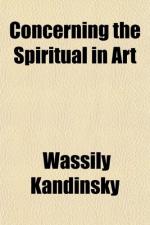This sharply defined working of individual colours is the basis on which various values can be built up in harmony. Pictures will come to be painted—veritable artistic arrangements, planned in shades of one colour chosen according to artistic feeling. The carrying out of one colour, the binding together and admixture of two related colours, are the foundations of most coloured harmonies. From what has been said above about colour working, from the fact that we live in a time of questioning, experiment and contradiction, we can draw the easy conclusion that for a harmonization on the basis of individual colours our age is especially unsuitable. Perhaps with envy and with a mournful sympathy we listen to the music of Mozart. It acts as a welcome pause in the turmoil of our inner life, as a consolation and as a hope, but we hear it as the echo of something from another age long past and fundamentally strange to us. The strife of colours, the sense of balance we have lost, tottering principles, unexpected assaults, great questions, apparently useless striving, storm and tempest, broken chains, antitheses and contradictions, these make up our harmony. The composition arising from this harmony is a mingling of colour and form each with its separate existence, but each blended into a common life which is called a picture by the force of the inner need. Only these individual parts are vital. Everything else (such as surrounding conditions) is subsidiary. The combination of two colours is a logical outcome of modern conditions. The combination of colours hitherto considered discordant, is merely a further development. For example, the use, side by side, of red and blue, colours in themselves of no physical relationship, but from their very spiritual contrast of the strongest effect, is one of the most frequent occurrences in modern choice of harmony. [Footnote: Cf. Gauguin, Noa Noa, where the artist states his disinclination when he first arrived in Tahiti to juxtapose red and blue.] Harmony today rests chiefly on the principle of contrast which has for all time been one of the most important principles of art. But our contrast is an inner contrast which stands alone and rejects the help (for that help would mean destruction) of any other principles of harmony. It is interesting to note that this very placing together of red and blue was so beloved by the primitive both in Germany and Italy that it has till today survived, principally in folk pictures of religious subjects. One often sees in such pictures the Virgin in a red gown and a blue cloak. It seems that the artists wished to express the grace of heaven in terms of humanity, and humanity in terms of heaven. Legitimate and illegitimate combinations of colours, contrasts of various colours, the over-painting of one colour with another, the definition of coloured surfaces by boundaries of various forms, the overstepping of these boundaries, the mingling and the sharp separation of surfaces, all these open great vistas of artistic possibility.




